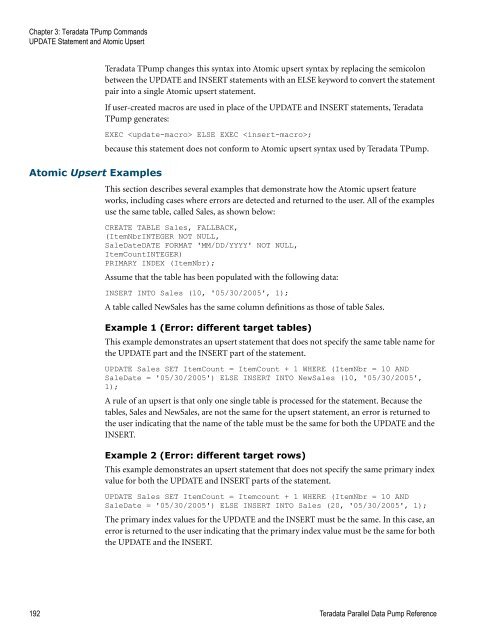Teradata Parallel Data Pump
Teradata Parallel Data Pump Reference - Teradata Developer ...
Teradata Parallel Data Pump Reference - Teradata Developer ...
- No tags were found...
Create successful ePaper yourself
Turn your PDF publications into a flip-book with our unique Google optimized e-Paper software.
Chapter 3: <strong>Teradata</strong> T<strong>Pump</strong> Commands<br />
UPDATE Statement and Atomic Upsert<br />
<strong>Teradata</strong> T<strong>Pump</strong> changes this syntax into Atomic upsert syntax by replacing the semicolon<br />
between the UPDATE and INSERT statements with an ELSE keyword to convert the statement<br />
pair into a single Atomic upsert statement.<br />
If user-created macros are used in place of the UPDATE and INSERT statements, <strong>Teradata</strong><br />
T<strong>Pump</strong> generates:<br />
EXEC ELSE EXEC ;<br />
because this statement does not conform to Atomic upsert syntax used by <strong>Teradata</strong> T<strong>Pump</strong>.<br />
Atomic Upsert Examples<br />
This section describes several examples that demonstrate how the Atomic upsert feature<br />
works, including cases where errors are detected and returned to the user. All of the examples<br />
use the same table, called Sales, as shown below:<br />
CREATE TABLE Sales, FALLBACK,<br />
(ItemNbrINTEGER NOT NULL,<br />
SaleDateDATE FORMAT 'MM/DD/YYYY' NOT NULL,<br />
ItemCountINTEGER)<br />
PRIMARY INDEX (ItemNbr);<br />
Assume that the table has been populated with the following data:<br />
INSERT INTO Sales (10, '05/30/2005', 1);<br />
A table called NewSales has the same column definitions as those of table Sales.<br />
Example 1 (Error: different target tables)<br />
This example demonstrates an upsert statement that does not specify the same table name for<br />
the UPDATE part and the INSERT part of the statement.<br />
UPDATE Sales SET ItemCount = ItemCount + 1 WHERE (ItemNbr = 10 AND<br />
SaleDate = '05/30/2005') ELSE INSERT INTO NewSales (10, '05/30/2005',<br />
1);<br />
A rule of an upsert is that only one single table is processed for the statement. Because the<br />
tables, Sales and NewSales, are not the same for the upsert statement, an error is returned to<br />
the user indicating that the name of the table must be the same for both the UPDATE and the<br />
INSERT.<br />
Example 2 (Error: different target rows)<br />
This example demonstrates an upsert statement that does not specify the same primary index<br />
value for both the UPDATE and INSERT parts of the statement.<br />
UPDATE Sales SET ItemCount = Itemcount + 1 WHERE (ItemNbr = 10 AND<br />
SaleDate = '05/30/2005') ELSE INSERT INTO Sales (20, '05/30/2005', 1);<br />
The primary index values for the UPDATE and the INSERT must be the same. In this case, an<br />
error is returned to the user indicating that the primary index value must be the same for both<br />
the UPDATE and the INSERT.<br />
192 <strong>Teradata</strong> <strong>Parallel</strong> <strong>Data</strong> <strong>Pump</strong> Reference









